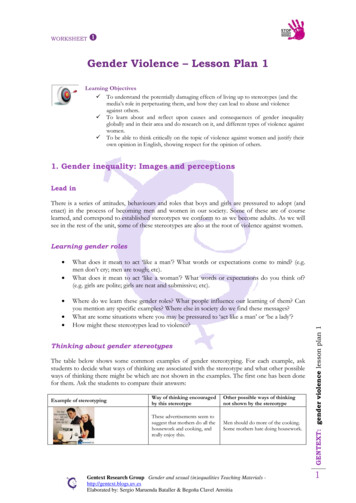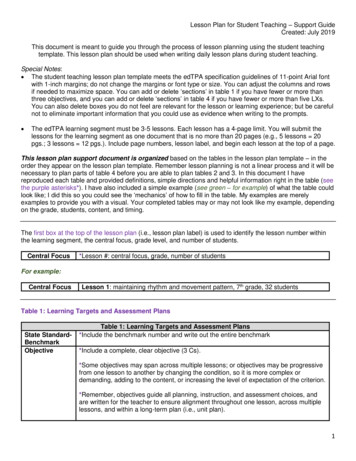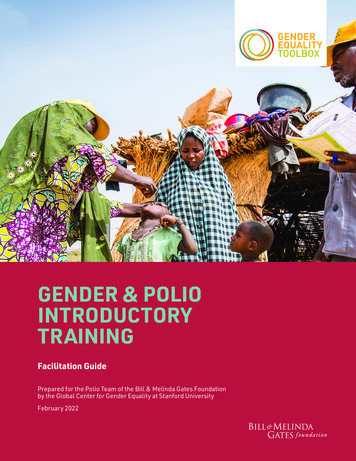
Transcription
WORKSHEET Gender Violence – Lesson Plan 1Learning Objectives To understand the potentially damaging effects of living up to stereotypes (and themedia’s role in perpetuating them, and how they can lead to abuse and violenceagainst others. To learn about and reflect upon causes and consequences of gender inequalityglobally and in their area and do research on it, and different types of violence againstwomen. To be able to think critically on the topic of violence against women and justify theirown opinion in English, showing respect for the opinion of others.1. Gender inequality: Images and perceptionsLead inThere is a series of attitudes, behaviours and roles that boys and girls are pressured to adopt (andenact) in the process of becoming men and women in our society. Some of these are of courselearned, and correspond to established stereotypes we conform to as we become adults. As we willsee in the rest of the unit, some of these stereotypes are also at the root of violence against women.Learning gender rolesWhere do we learn these gender roles? What people influence our learning of them? Canyou mention any specific examples? Where else in society do we find these messages?What are some situations where you may be pressured to ‘act like a man’ or ‘be a lady’?How might these stereotypes lead to violence?Thinking about gender stereotypesThe table below shows some common examples of gender stereotyping. For each example, askstudents to decide what ways of thinking are associated with the stereotype and what other possibleways of thinking there might be which are not shown in the examples. The first one has been donefor them. Ask the students to compare their answers:Example of stereotypingWay of thinking encouragedby this stereotypeOther possible ways of thinkingnot shown by the stereotypeThese advertisements seem tosuggest that mothers do all thehousework and cooking, andreally enjoy this.Men should do more of the cooking.Some mothers hate doing housework.Gentext Research Group Gender and sexual (in)equalities Teaching Materials http://gentext.blogs.uv.esElaborated by: Sergio Maruenda Bataller & Begoña Clavel ArroitiaGENTEXT: gender violence lesson plan 1What does it mean to act ‘like a man’? What words or expectations come to mind? (e.g.men don’t cry; men are tough; etc).What does it mean to act ‘like a woman’? What words or expectations do you think of?(e.g. girls are polite; girls are neat and submissive; etc).1
WORKSHEET Research into images and messagesSUGGESTEDACTIVITYIn groups, students investigate how men and women are portrayed to the public through themedia, how they behave and how they relate to each other. Different groups research:4 songs / lyrics4 TV series / films4 TV adverts4 pieces of newsGroups report their findings back to the class and explain how people of different genderswere being portrayed in their area of investigation. How were men and women shown to berelating to each other? Were these images realistic? Discuss the evidence and draw theconclusions.2. Gender inequality: facts, causes and consequences1. If sex refers to the biological differences between men and women, gender refers to a) Socially constructed roles and responsibilities of men and womenb) A concept that may change over time and vary within and between culturesc) Femininity and masculinityd) All of the abovee) Sex and gender have the same meaning and can be used interchangeably2. Gender equality is an issue that is relevant to:a) Girls and women; it is a women’s issueb) Developing countries; it is only there that gender gaps existc) All societies, women and men alike3. Why are girls more likely than boys to miss out on secondary education in the developing world?a) Because of high school fees, only boys go to schoolb) Many adolescent girls are expected to help out at homec) Child marriage restricts girls’ mobility and freedomd) All of the above.Gentext Research Group Gender and sexual (in)equalities Teaching Materials http://gentext.blogs.uv.esElaborated by: Sergio Maruenda Bataller & Begoña Clavel ArroitiaGENTEXT: gender violence lesson plan 1Gender quizDo the following quiz with your students and discuss their answers:2
WORKSHEET 4. Many women who are infected or at risk of becoming infected with HIV do not practice high-riskbehaviours, and are frequently married or in a monogamous relationship.a) True; women are vulnerable largely because of their limited autonomy and external factors,including violence against women and social and economic inequities beyond their controlb) False; marriage alone guarantees protection from HIV infection5. What fraction of the world’s working hours is worked by women and girls?a) 1/4b) 1/2c) 2/3d) 3/46. Obstacles faced by women entering the world of Information and Communication Technologies(ICTs) include:a) Women’s limited access to financial resources for buying ICT equipmentb) Unequal access to education and trainingc) Isolation of women in their homes or in remote placesd) All of the above7. Since 1901, the Nobel Prizes have been awarded to 768 individuals and 19 organizations. Howmany women have received this Prize?a) 12b) 33c) 77d) 1588. Looking at the issue of violence against women from a gender perspective one recognizes that a) Male violence towards women is instinctive. Women have to accept a certain degree of violenceb) Violence against women is a manifestation of prevailing unequal power relations betweenwomen and menc) It is also women’s fault if men are violent with women.10. Gender equality supports:a) Poverty eradicationb) Education for All goalsc) Reduction of HIV infectionsd) Increase in family incomee) All of the aboveReading ComprehensionWomen Hold Up Half the Sky (Chinese saying)What do you think this saying means? Is it true to our society? Why (not)?Global gender inequalityGender inequality starts early and keeps women at a disadvantage throughout their lives. Insome countries, infant girls are less likely to survive than infant boys because their parentsfavour the boys and neglect the girls – even though biologically, infant girls should survive ingreater numbers.Girls are more likely to drop out of school and to receive less education than boys because ofdiscrimination, education expenses, and household duties.In 1995, governments around the world signed the Beijing Platform For Action, promising toGentext Research Group Gender and sexual (in)equalities Teaching Materials http://gentext.blogs.uv.esElaborated by: Sergio Maruenda Bataller & Begoña Clavel ArroitiaGENTEXT: gender violence lesson plan 19. Which strategies help women become more socially and economically empowered?a) Women working together to challenge discriminationb) More income sources for womenc) Improved access to educationd) All of the above3
WORKSHEET take specific action to prevent discrimination against women. Yet today, more than 40 countrieshave laws which discriminate against women and treat them as second-class citizens. In manycountries, women are subjected to violence, which the government does nothing to stopbecause their laws approve practices like ’honour’ killings, (where a woman is killed by a familymember if she does something which is thought to bring shame on the family), marital rape andwife beating. In several countries laws make it more difficult for a woman to be independentbecause they restrict women’s property, employment and citizenship rights.-Out of 1.3 billion people in the world living in absolute poverty, over 70 per cent arewomen.At the present rate of progress, it will take 450 years before women reach equality withmen as senior managers.Women hold less than 5 per cent of the top positions in international organisations likethe United Nations and the European Union.Of the 150 million children in the world aged 6-11 who do not attend school, over 90million are girls. Of 876 million illiterate people over 15 years in the world, two-thirds arewomen.Worldwide, women’s wages are 30-40 per cent lower than those of men doingcomparable work.Average hourly earnings for women working full-time are 18% lower than for menworking full-time in the UK, and for women working part-time, hourly earnings are 40%lower.In 2005 there were 42,832 MPs in the world. 15.7 per cent are women. Only around 6per cent of government ministers worldwide are women.500,000 women die each year from causes related to pregnancy and childbirth.In the 15-40 age range, 75 per cent more women die than men.Some 201 million women, most of them in developing countries, still have no access tocontraceptive services. Meeting their needs would prevent an estimated 23 million.unplanned births, and 1.4 million infant deaths.From: Amnesty International Women’s Rights Workbook. (adapted)TaskIn small groups, read the information sheet Global Gender Inequality and indentify whichfactors are a cause of gender inequality, which are a consequence of gender inequalityand which are both a cause and a consequence. Complete the table.GLOBAL GENDER INEQUALITYConsequencesWhich facts surprised you most and why?SUGGESTEDACTIVITYWhat are the fact and figures about women in your local area? What proportion of localcouncillors are women? Senior managers and professionals? Unemployed people? Part-timeand low-paid workers? Write a report.‘In no society do women enjoy the same opportunities as men.’ Write an article for a magazinewhich explores this statement.Gentext Research Group Gender and sexual (in)equalities Teaching Materials http://gentext.blogs.uv.esElaborated by: Sergio Maruenda Bataller & Begoña Clavel ArroitiaGENTEXT: gender violence lesson plan 1Causes4
WORKSHEET 3. Violence against WomenDiscrimination and inequality are at the root of violence against women. Historicallywomen have been seen as less important than men; lower than them; of less value than menpolitically, socially, economically and culturally. In the past both law and custom made womenthe property of men. Wherever social attitudes devalue women, violence against women is morelikely to be tolerated or less likely to be punished. Arguments to justify violent methods to ‘keepwomen in their place’ and to assert male dominance may call upon ‘religious principles’, or‘cultural traditions’. Until recently, domestic violence in the some Western countries was seen asa ‘private matter’ outside the power of the law to intervene. Indeed, it was only after years ofcampaigning by women’s groups and human rights organisations that domestic violence wascriminalised and taken seriously.DiscussionPrepare a set of controversial statements about gender and violence against women and girls for theclass to discuss. Present each statement and ask students whether they agree or disagree, or don’tknow. Invite some students to justify their position.Agree or disagree?Violence against women is really not a problem in Spain. Women enjoy equalrights here, don’t they?Girls are less valued than boys in all societies.Men are naturally more physically aggressive than women.Girls who flirt or get drunk are ‘asking for it’.In China and India there are equal numbers of boy babies and girl babies.In Europe more women aged from 16 to 44 die (or are severely disabled) fromheart attacks, cancer or from traffic accidents than from domestic violence.Men prefer submissive women.Men who are violent towards women are emotionally immature.Few women and girls in this country have experienced severe beating, rape orsexual abuse.‘Violence against women is perhaps the most shameful human rights violation, and it is perhaps the mostpervasive. It knows no boundaries of geography, culture or wealth. As long as it continues, we cannot claimto be making real progress towards equality, development and peace.’Kofi Annan, former UN Secretary GeneralDefinitionsDefine ‘violence against women’ in your own words. Discuss answers with the group.Does violence against women and girls occur in only some countries, or affect only certain groupsof women? Can you mention any examples you have heard or read about?What are, in your opinion, the causes of violence against women?Violence against women includes, among others, violence in the family, at work and in thecommunity, and in armed conflicts. How many instances do you know?Gentext Research Group Gender and sexual (in)equalities Teaching Materials http://gentext.blogs.uv.esElaborated by: Sergio Maruenda Bataller & Begoña Clavel ArroitiaGENTEXT: gender violence lesson plan 1Facts about violence against women5
WORKSHEET Violence in the familyViolence at work / in thecommunityViolence in armedconflictsThe Stop Violence against Women CampaignAmnesty International’s global campaign to stop violence against women was launched onInternational Women’s Day in March 2004.The campaign focuses on identifying and exposing acts of violence in the home, and in conflictand post conflict situations globally. It calls on governments, communities and individuals totake action to prevent such acts and provide redress.By resolution 54/134 of 17 December 1999, the General Assembly designated 25 November asthe International Day for the Elimination of Violence against Women, and invited governments,international organizations and NGOs to organize activities designated to raise public awarenessof the problem on that day. Women's activists have marked 25 November as a day againstviolence since 1981. This date came from the brutal assassination in 1960, of the three Mirabalsisters, political activists in the Dominican Republic, on orders of Dominican ruler RafaelTrujillo (1930-1961).On 20 December 1993 the General Assembly adopted Declaration on the Elimination ofViolence against Women (A/RES/48/104).Domestic ViolenceQuestions:1. What is the main theme of the song? How did you feel while watching it?2. What other issues are shown in the video (related to the theme)?3. What is the wall the song alludes to? Do you know of any other walls?4. Which are the main factors that contribute to violence against women?5. Mention other instances of violence against women.ListeningListen to the recording about some of the causes of gender violence in abusiverelationships and answer the questions that follow:1. Mention at least three ways of using power and abuse to dominate a partner.2. How can psychological abuse be even more damaging than physical abuse?3. What is the hidden side of domestic violence? Why is it ‘hidden’?4. Mention two reasons why people stay in an abusive relationship, according tothe speaker.5. Read the following words or expressions from the transcript and match withtheir meaning in context:Gentext Research Group Gender and sexual (in)equalities Teaching Materials http://gentext.blogs.uv.esElaborated by: Sergio Maruenda Bataller & Begoña Clavel ArroitiaGENTEXT: gender violence lesson plan 1Click on Play to watch the video and then answer the questions below:6
WORKSHEET Word / ExpressionMeaning1. It is rarely a one-off event.2. Jealousy is a formidable spur for manya. very unexpected.b. to deal with a problem or a difficult situation veryquickly, as it has become worse.attacks.3. Have you been on the receiving end of aviolent attack?4. It can be something which whittles away atyour self-esteem 5. Other times an attack can come out of theblue.6. This usually covers up a reluctance to bringthings to a head and face all the changes that achallenge might bring about.c. to gradually reduce something.d. happening or done only once, not as part of aregular series.e. incitement.f. to be the person who is affected by someone else’sactions, usually in an unpleasant way.4. AssessmentChoose one of the following options:On November 25 2010 we celebrate the International Day for the Elimination of Violence againstWomen. Design a campaign to stop violence against women. Make up a digital story.Bearing in mind what seen in the lesson plan, hold a debate on the opposing statements:‘We believe that gender inequality is a natural consequence of biological differences and willalways exist’.‘We believe gender inequality is rooted in attitudes, society and culture and with effort canbe eliminated.Select one of the factors to research (e.g. health; literacy and education; poverty and economicpower, legislation that discriminates against women) and report back on. Try to answer thefollowing questions:How does this inequality affect women’s lives?How is it similar or different across the world?How might each inequality be eradicated?Why is violence against women legitimised in some countries? Give examples.5. ReferencesSection for Women and Gender Equality Bureau of Strategic Planninghttp://portal.unesco.org/en/ev.php URL ID 3160&URL DO DO TOPIC&URL SECTION 201.htmlBBC Learning Zone – Domestic violence: a young person’s htmlITVS – Gender Violence for /hip-hop/lesson-plans/gender-violenceAmnesty International – Women’s rights: Stop violence against yID 11639Hidden Hurt – Domestic abuse informationhttp://www.hiddenhurt.co.uk/Gentext Research Group Gender and sexual (in)equalities Teaching Materials http://gentext.blogs.uv.esElaborated by: Sergio Maruenda Bataller & Begoña Clavel ArroitiaGENTEXT: gender violence lesson plan 11.2.3.4.7
WORKSHEET GENTEXT: gender violence lesson plan 1Family Violence Prevention l/756/Gentext Research Group Gender and sexual (in)equalities Teaching Materials http://gentext.blogs.uv.esElaborated by: Sergio Maruenda Bataller & Begoña Clavel Arroitia8
To be able to think critically on the topic of violence against women and justify their own opinion in English, showing respect for the opinion of others. 1. Gender inequality: Images and perceptions Lead in There is a series of attitudes, behaviours











